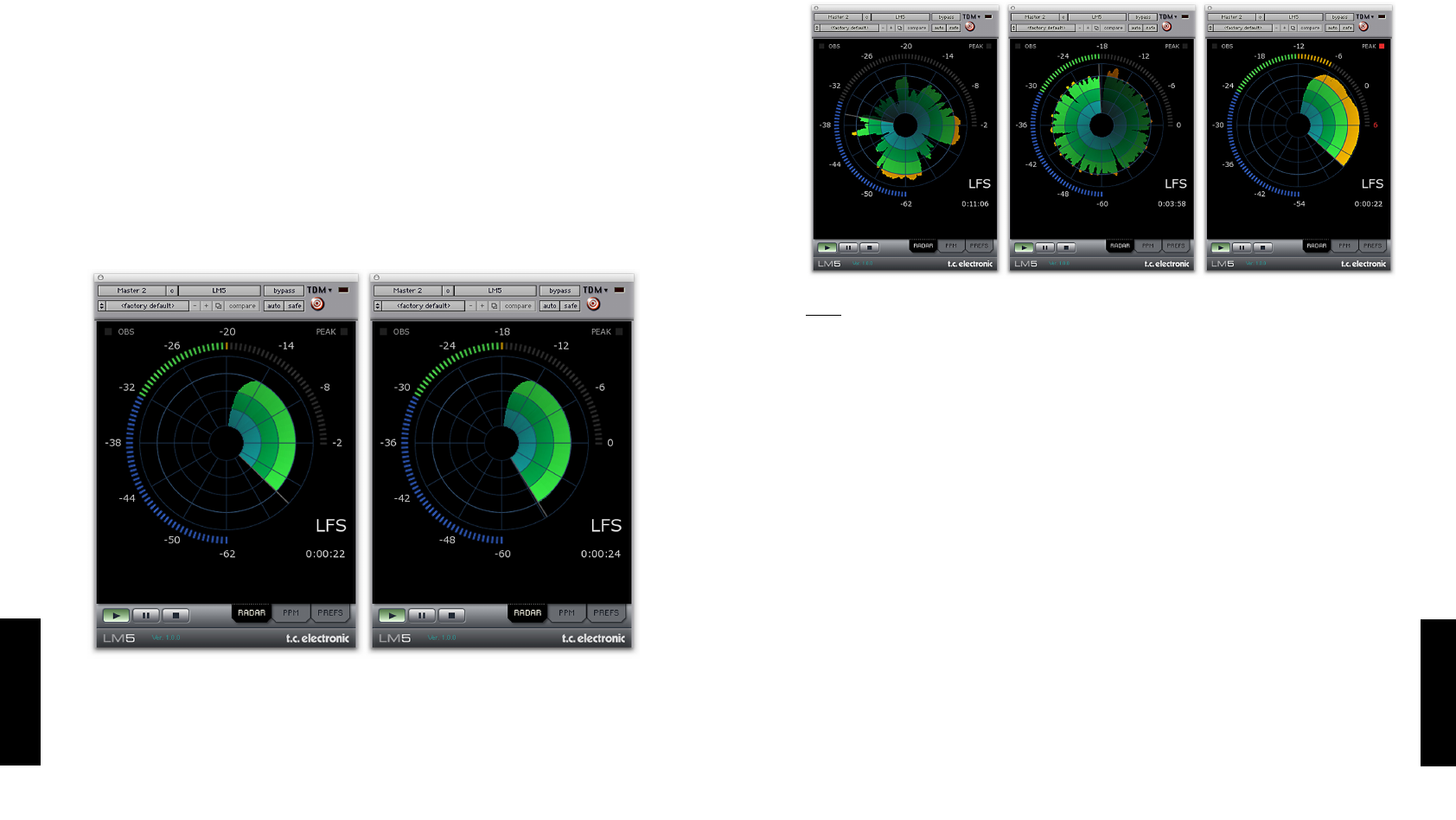
EE NN GG LL II SS HH
6/
LM5 & LM5D -TDM
LM5 & LM5D -TDM
/
7
EE NN GG LL II SS HH
RADAR PAGE
Current Loudness: Outer Ring
The outer ring of the Radar page displays current loudness. The 0 LU point (i.e. Target
Loudness) is at 12 o’clock, and marked by the border between green and yellow, while
the Low Level point is marked by the border between green and blue. The “0 LU
Equals” and “Low Level Below” parameters are found on Prefs page. For instance, if
0 LU is set at -20 LFS, and Low Level is set at -12 LU, the color coding of Fig 3
applies.
The user should be instructed to keep the outer ring in the green area, and around 12
o’clock on the average. Excursions into the blue or the yellow area should be
balanced, and not only go in one direction.
The numbers associated with the outer ring may be referenced at either maximum
loudness, or have a zero point set somewhere mid-scale. Choose “LFS” or “LU” at the
Loudness Scale selection on the Prefs page depending on your preference. Either way
of looking at loudness is valid. LFS reading is in line with how peak level is typically
measured in a digital system, and with Dolby LM100, while the LU approach calls for
a certain Target Loudness to have been predetermined, like e.g. a VU meter.
Fig 4, Radar page displaying calibration tones.
Left meter: Standard NAB preset. 1 kHz, stereo sine at –20 dBFS.
Right meter: Standard EBU preset. 1 kHz, stereo sine at –18 dBFS.
LOUDNESS HISTORY: RADAR
The Loudness Radar shows a history of loudness over time. The loudness “landscape”
may be used to judge if loudness emphasis is put where you want it to be: If dialog
segments are balanced against action parts, if the chorus of a song has a lift against
the verse, if the audience is too loud in a gameshow, or maybe as a target to aim for
during a live transition etc.
Fig 5, Different types of program shown on the Radar.
Left: 5.1 movie:
Pirates of the Caribbean on a 12 minute per revolution Radar: Low Consistency.
Center:
German news broadcast on a 4 minute per revolution Radar: Medium Consistency.
Right:
Madonna’s Hung Up pop on a one minute per resolution Radar: High Consistency.
The duration of one radar revolution may be set between 1 minute and 24 hours. The
Radar has 3, 4, 6, 8, 10 or 12 dB between each concentric circle, while the 0 LU
point is always marked as the border between green and yellow at the bold concentric
circle, see Fig 3. The 0 LU point is set on the Prefs page, typically between -12 and -
24 LFS.
The “Transport Controls” (lower left on the display) are used to make the Radar run,
pause or reset. Note that these controls in LM5D appear as shown in Fig 3.
The OBS indicator is lit to show certain inter-channel anomalies. Such conditions may
be defined on the Prefs page. The OBS indicator would typically trigger the operator to
switch to PPM page for a closer look of what’s going on.
The Peak indicator is lit to show that at least one channel is exceeding its true-peak
max. The threshold of the Peak Indicator is defined on the Prefs page, and recalled
with an LM5 preset.














